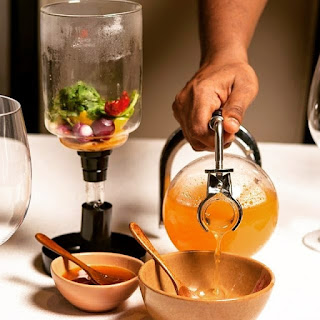Freezing the ice ...liquid nitrogen* (disclaimer doesn't say the safetyprecautions needed)
Cooking is a technique associated with heat that is what I have always assumed until I happened to witness what liquid nitrogen is capable of, and it brought to me a new dimension on how I perceived the meaning of cooking, the term "Where there is smoke there is fire" sure seemed to be a distant lie.
"Cooling rapidly" is a term which defines a stage on the process of cooling; The blast chillers are the idealistic equipment which helps us to achieve the desired results in terms of temperature where the Micro organism or the bacteria is pushed towards hibernation, and this happens from temperatures below 5 degree centigrade;So the failure of falling a prey to bacteria is all but a myth when working with liquid nitrogen.
Now -let's first understand what is nitrogen? It is the primary component in our atmosphere it basically forms the 78% of the earths atmosphere. The Earth's atmosphere plays a vital role in sustaining life on this planet. Oxygen is needed for respiration by animals, plants, and some bacteria. Nitrogen is an inert gas that reduces the amount of oxygen available for the oxidation of natural materials, thus restricting spontaneous combustion (burning) of flammable materials and the corrosion of metals. Nitrogen is also used by "nitrogen-fixing" bacteria to produce compounds that are useful for plant growth. Plants that perform photosynthesis take up carbon dioxide from the air and release oxygen. Carbon dioxide and water vapor act as "greenhouse gases" that keep the Earth sufficiently warm to maintain life. Water vapor in the air is part of the water cycle that produces precipitation (such as rain and snow) that replenishes moisture in the soil. In addition, water vapor prevents exposed living tissue from drying up.
So; it ain't that dangerous when we say liquid
Nitrogen ; What’s the coldest thing you can think of? (ice is +32 F, dry ice [CO2] is –109 F) What we have here is liquid nitrogen, its temperature is minus 320 degrees Fahrenheit . So what we have here is liquid air. It took a really powerful refrigerator to make the air so cold that it turns into a liquid. Most gases turn into a liquid when they get cold enough. What’s all this bubbling, does it remind you of anything? (boiling water). It’s actually a lot like boiling water. When you boil water, you make the pot really hot until it gets to a specific temperature, called the boiling point, then the liquid starts turning into a gas. For water the boiling point is 212 degrees, that’s why we need to heat it on a stove. For nitrogen the boiling point is minus 320 degrees, so the liquid nitrogen is boiling at room temperature to become air. What is this smoke coming off the nitrogen, does that remind you of anything? (fog). It actually is the same as fog. The liquid nitrogen makes the nearby air very cold. The air can’t hold as much water vapour when it’s colder, so some of the water vapour condenses into small water droplets that we see as fog, just like you can see over the ocean in the morning.
Enough of science; now how can one use liquid nitrogen in cooking other than using it for rapid cooling; In cooking, liquid nitrogen is used as a coolant. It is not an ingredient and so it is never ingested; it cools the food, then evaporates. It is only after complete evaporation of the liquid nitrogen that the food can be ingested. Foods that are cooled with liquid nitrogen are extremely cold as they have been in contact with this cryogenic substance, and should be left to warm up before being touched and ingested, in the same way that foods dipped in boiling oil must cool down before being touched. The denser the food, the colder it will be and therefore the longer it will need to warm up. This is why chefs typically use liquid nitrogen to make meringues or frozen mousse, that is to say, they dip very low density confections.
Some chefs use the cooling properties of liquid nitrogen to make especially unctuous ice creams. The creaminess of the ice cream is obtained thanks to the small size of the ice crystals formed during cooling with liquid nitrogen. It is also possible to create amazing appetizers like frozen meringue or mousse. Liquid nitrogen finally makes it possible to freeze alcohol to make original cocktails, which is not possible with traditional freezing.
Ferran adria used this technique to create the "cheese globe" and this method has be absorbed by chefs and turning it into their own sheen and creating various other classics.
The instant ice-cream is another flair which with a bit of skill and controlled approach it's an easy affair .





Comments
Post a Comment